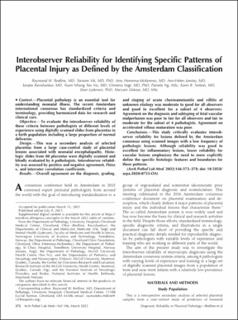| dc.contributor.author | Redline, Raymond W. | |
| dc.contributor.author | Vik, Torstein | |
| dc.contributor.author | Heerema-McKenney, Amy | |
| dc.contributor.author | Jamtøy, Ann-Helen | |
| dc.contributor.author | Ravishankar, Sanjita | |
| dc.contributor.author | Ton Nu, Tuyet Nhung | |
| dc.contributor.author | Vogt, Christina | |
| dc.contributor.author | Ng, Pamela | |
| dc.contributor.author | Nelson, Karin B. | |
| dc.contributor.author | Lydersen, Stian | |
| dc.contributor.author | Oskoui, Maryam | |
| dc.date.accessioned | 2023-05-11T07:22:54Z | |
| dc.date.available | 2023-05-11T07:22:54Z | |
| dc.date.created | 2022-01-12T10:37:34Z | |
| dc.date.issued | 2021 | |
| dc.identifier.citation | Archives of Pathology & Laboratory Medicine. 2021, . | en_US |
| dc.identifier.issn | 0003-9985 | |
| dc.identifier.uri | https://hdl.handle.net/11250/3067572 | |
| dc.description.abstract | Context.—: Placental pathology is an essential tool for understanding neonatal illness. The recent Amsterdam international consensus has standardized criteria and terminology, providing harmonized data for research and clinical care. Objective.—: To evaluate the interobserver reliability of these criteria between pathologists at different levels of experience using digitally scanned slides from placentas in a birth population including a large proportion of normal deliveries. Design.—: This was a secondary analysis of selected placentas from a large case-control study of placental lesions associated with neonatal encephalopathy. Histologic slides from 80 placentas were digitally scanned and blindly evaluated by 6 pathologists. Interobserver reliability was assessed by positive and negative agreement, Fleiss κ, and interrater correlation coefficients. Results.—: Overall agreement on the diagnosis, grading, and staging of acute chorioamnionitis and villitis of unknown etiology was moderate to good for all observers and good to excellent for a subset of 4 observers. Agreement on the diagnosis and subtyping of fetal vascular malperfusion was poor to fair for all observers and fair to moderate for the subset of 4 pathologists. Agreement on accelerated villous maturation was poor. Conclusions.—: This study critically evaluates interobserver reliability for lesions defined by the Amsterdam consensus using scanned images with a low frequency of pathologic lesions. Although reliability was good to excellent for inflammatory lesions, lower reliability for vascular lesions emphasizes the need to more explicitly define the specific histologic features and boundaries for these patterns. | en_US |
| dc.language.iso | eng | en_US |
| dc.publisher | College of American Pathologists | en_US |
| dc.relation.uri | https://allen.silverchair-cdn.com/allen/content_public/journal/aplm/pap/10.5858_arpa.2020-0753-oa/2/10.5858_arpa.2020-0753-oa.pdf?Expires=1645004168&Signature=hfLPB7LT6kaDvhTkWMg7cLJJS0ZXbA0Gbm1WjanpO | |
| dc.title | Interobserver Reliability for Identifying Specific Patterns of Placental Injury as Defined by the Amsterdam Classification | en_US |
| dc.title.alternative | Interobserver Reliability for Identifying Specific Patterns of Placental Injury as Defined by the Amsterdam Classification | en_US |
| dc.type | Peer reviewed | en_US |
| dc.type | Journal article | en_US |
| dc.description.version | publishedVersion | en_US |
| dc.source.pagenumber | 7 | en_US |
| dc.source.journal | Archives of Pathology & Laboratory Medicine | en_US |
| dc.identifier.doi | 10.5858/arpa.2020-0753-OA | |
| dc.identifier.cristin | 1979153 | |
| cristin.ispublished | true | |
| cristin.fulltext | original | |
| cristin.qualitycode | 1 | |
